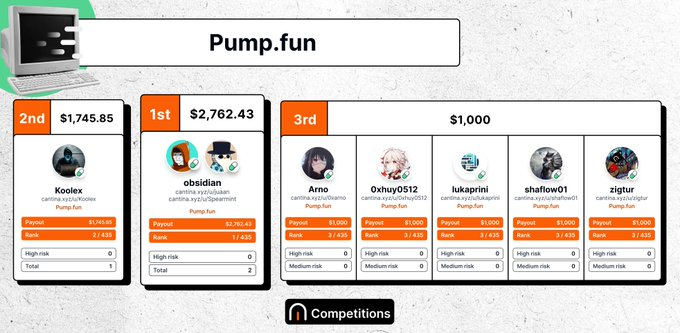Pump.fun’s $4 Billion Valuation Token Sale Plan
On June 3, 2025, according to Blockworks citing multiple insiders, Pump.fun, a leading Memecoin issuance platform on the Solana ecosystem, plans to conduct a $1 billion token sale at a fully diluted valuation (FDV) of $4 billion, targeting both public and private investors. The token is expected to launch within the next two weeks, but the issuance channel is yet to be confirmed (possibly via its own platform or third-party exchanges). This announcement directly contradicts founder Alon’s earlier public denial of a token launch, raising questions about the project’s transparency and strategic intent.

This market insight article analyzes Pump.fun’s $4 billion valuation funding plan, discussing its business model, market controversy, and potential impact on the Memecoin ecosystem.
Business Model: The Core Engine of Memecoin Industrialization
Pump.fun positions itself as a zero-barrier token launch platform where users can create tokens on Solana for just 0.02 SOL (around $3), without writing smart contracts or requiring technical expertise. Its business model relies on three revenue streams:
-
Token creation fee: Each token launch incurs a fixed cost (~$2–3);
-
Transaction fees: 1% is charged on every trade, with 0.05% allocated to token creators;
-
Listing fees: Tokens reaching a $100,000 market cap are auto-listed on Raydium, with the platform charging 6 SOL for listing and earning a share of future trading revenue.
This model has delivered impressive financial results: as of February 2025, the platform generated over $560 million in cumulative revenue, with a daily peak revenue of $15.88 million, making it one of the most profitable DApps in crypto history.
Controversy: Credibility Crisis and Mechanism Flaws
Contradictory Statements from the Founder
Founder Alon had publicly denied token plans in February 2025, but the large-scale funding news undermines his credibility. As early as December 2024, a leaked token allocation plan indicated: 50% of the 420 million total supply would be sold via Dutch auction, 25% allocated to the team, and 22.05% to early investors. If accurate, over 47% of tokens would be controlled by the team and institutions, potentially weakening decentralization.
Moral Hazard in Revenue Sharing Mechanism
The “Creator Revenue Sharing Plan” launched in May 2025 allocates 0.05% of trading fees to token creators, aiming to encourage long-term project operation. However, the community strongly opposes it, arguing this effectively “pays scammers” since over 99% of platform tokens are speculative and many mimic official projects.
Liquidity Drain Allegations
Since early 2025, Pump.fun has transferred 1.32 million SOL (~$260 million) to Kraken, sparking accusations of “draining ecosystem liquidity.” Meanwhile, the decline in Solana ecosystem activity has led to a sharp drop in daily token deployments from 60,000 to 22,000, signaling growth fatigue.
Market Impact: Potential Restructuring of the Memecoin Ecosystem
Impact on Competitive Landscape
If the $1 billion raise succeeds, Pump.fun will secure ample capital to consolidate its dominance, potentially prompting three types of competitors to pivot:
-
Decentralized alternatives like XBIT, which attract users through trustless and censorship-resistant features;
-
Vertical platforms like Virtuals Protocol, shifting focus to AI Agent token creation;
-
Exchange-built systems: Binance, Bybit, and others have previously developed Dutch auction models to capture the token launch market.
Retail Behavior Evolution
Crypto KOL匹馬 pointed out that Pump.fun’s success hinges on capturing retail investors’ “behavioral finance logic”—users often decide within 6 minutes, seeking quick returns. However, the model is entering a negative cycle: excessive token launches cause 99% of projects to fail to “graduate” to Raydium, leading to increased participant losses and eroded trust.
Valuation Bubble Concerns
A $4 billion FDV implies a 33x price-to-earnings ratio based on annualized revenue (~$120 million), far exceeding traditional fintech levels. For comparison:
-
Uniswap’s FDV/revenue ratio is ~8x;
-
Coinbase’s P/E at IPO was under 20x.
Such a high valuation relies on continued Memecoin market frenzy, but declining activity on Solana signals potential risks.
Future Scenarios: Regulatory and Ecosystem Balance Challenges
Rising Regulatory Scrutiny
The U.S. SEC may classify the token sale as an unregistered securities offering, particularly if the team retains 25% of tokens without a lock-up, reinforcing “centralized control” concerns. Previous cases (e.g., Coinbase lawsuit) show regulators cracking down on disguised equity fundraising via token allocations.
Mechanism Adjustments Needed
To restore community trust, Pump.fun must optimize two key mechanisms:
-
Anti-fraud system: Integrate on-chain behavior analysis to detect Sybil accounts and prevent scam tokens with official-like names;
-
Liquidity retention: Reduce asset transfers to centralized exchanges and enhance internal ecosystem circulation.
Investors can monitor real-time regulatory developments via the JuCoin compliance tracking platform.
Repositioning Industry Significance
Pump.fun’s success or failure could serve as a litmus test for Memecoin “industrialization”: if it proves that capitalized operations can improve project survival (current graduation rate <1%), it may elevate Memecoins from speculative bets to sustainable community assets; if it fails, it will reaffirm the market’s ultimate demand for “fair and decentralized distribution.”




